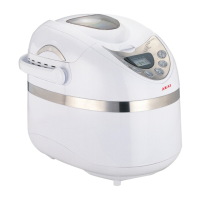13
8 The bread size is
too small or the
bread has not
risen.
You have forgotten to
add the yeast or there is
too little. Alternatively,
the yeast may have
poor activity, the water
temperature is too
high, the yeast is mixed
together with salt or the
temperature of the bread
maker is too low.
Check the amount and
performance of the yeast
and/or increase the inside
temperature of the bread
maker to ensure that the bread
can expand and reach it’s full
size.
9 The dough is
so large it’s
overflowing out
of the bread pan.
There is an excessive
amount of liquid and/or
yeast which makes the
dough too soft, causing it
to overexpand.
Reduce the amount of liquid
and/or yeast to improve
dough rigidity.
10 The bread
collapses in
the middle
when baking
the dough.
1. The flour used is not
suitable and therefore
can’t make the dough rise.
2. The yeast rate is too
rapid or the yeast
temperature is too high.
3. Excessive water makes the
dough too wet and soft.
Use bread flour or other
suitable flour.
Only use yeast at a cool
temperature.
Adjust the water content till
you have a suitable wet to dry
ingredients ratio, as specified
in the recipe.
11 Bread weight is
very heavy and
the bread is
too dense.
1. Too much flour and too
little water.
2. Too many fruit
ingredients or too much
wholemeal flour.
Reduce the flour or increase
the water volume.
Reduce the amount of
corresponding ingredients and
increase the yeast.
12 The middle parts
are hollow after
slicing through
the bread.
1. Excessive water or yeast
and not enough salt.
2. The water temperature is
too high.
Reduce the amount of
water or yeast and check the
salt content. Also check the
water temperature.
13 The bread
surface has
adhered to the
dry powder.
1. There are strong
glutinous ingredients in
the bread such as butter
and bananas etc.
2. Inadequate stirring has
occurred due to a lack
of water content.
Do not add strong glutinous
ingredients to the bread.
Check the water content and
the inside surface area of the
bread maker.

